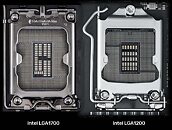- Joined
- Oct 9, 2007
- Messages
- 47,655 (7.44/day)
- Location
- Dublin, Ireland
| System Name | RBMK-1000 |
|---|---|
| Processor | AMD Ryzen 7 5700G |
| Motherboard | Gigabyte B550 AORUS Elite V2 |
| Cooling | DeepCool Gammax L240 V2 |
| Memory | 2x 16GB DDR4-3200 |
| Video Card(s) | Galax RTX 4070 Ti EX |
| Storage | Samsung 990 1TB |
| Display(s) | BenQ 1440p 60 Hz 27-inch |
| Case | Corsair Carbide 100R |
| Audio Device(s) | ASUS SupremeFX S1220A |
| Power Supply | Cooler Master MWE Gold 650W |
| Mouse | ASUS ROG Strix Impact |
| Keyboard | Gamdias Hermes E2 |
| Software | Windows 11 Pro |
Here's the first picture of Intel's upcoming mainstream desktop processor socket, the LGA1700, which was until now only seen in renders or technical drawings. The socket is characterized by a more rectangular contact pad than previous Intel sockets. The Socket H family (LGA115x and LGA1200) that ruled Intel MSDT sockets for over a decade, has a largely square pad. Intel's HEDT sockets such as the LGA1366, LGA2011 and LGA2066, on the other hand, had a rectangular pad, though not as pronounced (slender) as the LGA1700.
From the looks of it, the retention mechanism of the LGA1700 appears similar to that of Socket H and most other Intel LGA sockets (though dissimilar from the LGA2011/LGA2066). In its client desktop avatar, the LGA1700 has 100 unused pins. This is because the socket is physically identical to the LGA1800, which is speculated to be left for future generations of Intel processors with additional power or I/O pins. The Z-height of LGA1700 is lower than that of Socket H, which entails a major change in the retention module design of most aftermarket CPU cooling solutions.


The LGA1700 socket and Intel 600-series chipset platform will support at least two processor generations—12th Gen "Alder Lake" and 13th Gen "Raptor Lake." Built on the same Intel 7 node (10 nm Enhanced SuperFin) node as "Alder Lake," the next-generation "Raptor Lake" silicon will feature 8 "Raptor Cove" Performance cores, and 16 "Gracemont" Efficiency-cores. It's expected to debut by late-2022.
View at TechPowerUp Main Site
From the looks of it, the retention mechanism of the LGA1700 appears similar to that of Socket H and most other Intel LGA sockets (though dissimilar from the LGA2011/LGA2066). In its client desktop avatar, the LGA1700 has 100 unused pins. This is because the socket is physically identical to the LGA1800, which is speculated to be left for future generations of Intel processors with additional power or I/O pins. The Z-height of LGA1700 is lower than that of Socket H, which entails a major change in the retention module design of most aftermarket CPU cooling solutions.


The LGA1700 socket and Intel 600-series chipset platform will support at least two processor generations—12th Gen "Alder Lake" and 13th Gen "Raptor Lake." Built on the same Intel 7 node (10 nm Enhanced SuperFin) node as "Alder Lake," the next-generation "Raptor Lake" silicon will feature 8 "Raptor Cove" Performance cores, and 16 "Gracemont" Efficiency-cores. It's expected to debut by late-2022.
View at TechPowerUp Main Site






